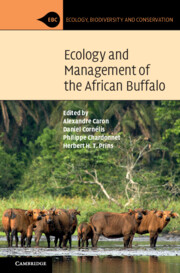This book, edited by four researchers experienced in different aspects of African buffalo biology, provides us with the most up-to-date story of what is known and not known of the wild species and how it may be managed for the benefit of humans. It is an extensive compilation of knowledge about a species that is emerging as an important component of African natural and human ecosystems. There are five parts of this story. We are provided with a synthesis of what is known of the conservation and ecology of the African buffalo in nature. Then, we see how this knowledge combined with new information on disease ecology can lead to management in both wild and semi-captive conditions.
After an introduction dealing with the interaction of buffalo and humans, the second part presents new information on the genetics, phylogeny and evolution of the species, confirming now that there are three subspecies – the eastern and southern savanna type, the dwarf forest type of central African forests and the northern savanna type from which the forest form evolved. This leads to a discussion of the conservation status of the species. The third part, the ecology, covers distribution within Africa – increasingly confined to Protected Areas – social organization and population trends, which are largely decreasing due to direct threats from human exploitation and disease, and indirect threats from habitat loss. Populations are also disturbed from their equilibrium by environmental perturbations such as droughts because buffalo are very much water-dependent. There is new information from modern remote-sensing technology on space use, movements and social behaviour. Movements and social behaviour are interlinked – female herds can show small cohesive and sedentary groups with constant membership, as in Uganda and some small montane forest habitats, but they can also form highly flexible herds, of up to 2000 in number. These can split up, reform seasonally, and the groups can intermix. These subgroups have overlapping home ranges. Such herds are found in extensive savanna habitats, and have been shown in southern Africa to perform long-distance migrations.
In the fourth part, new information is presented on the diseases of African buffalo. There are a large number of micro- and macro-parasite species that are endemic in buffalo. Most of these play an important role in expediting the regulation of populations by synergistically interacting with lack of food. There are, however, a few species that cause episodic outbreaks and high mortality, but only a few. Of course, there was once the well-known exotic virus, rinderpest, introduced to Africa in 1889 from Asia, causing catastrophic mortality, but that disease has now been eradicated from the world. We see that buffalo can suffer from diseases contracted from cattle, and equally there are endemic buffalo diseases that can be transmitted to domestic animals. This information is vital for both the conservation of wild populations and the management of domestic herds in the presence of wild buffalo.
The husbandry of African buffalo is covered in the fifth part. Much of this concerns private land, and the legal basis for this is explained – so far mostly in southern African countries. This covers the genetics of populations on private land and the control of parasites and diseases. We are then provided with biological statistics on such production aspects as densities allowable on land, distribution in different habitats, growth and breeding capability. We see the different advantages and disadvantages of these aspects in a comparison with cattle. One of the difficulties with buffalo is how to handle them, being less docile than cattle and more highly stressed; a discussion is offered on how to deal with this problem. The husbandry of buffalo on private land for trophy hunting is outlined.
This book is designed for wildlife students, researchers and managers. The information is valuable for management in wild populations and for situations where buffalo and domestic stock could coexist. Most of the information comes from the savanna subspecies of buffalo. Little is known about the other two types, and especially the miniature forest form. The book ends with a discussion of what we know and what we still have to learn. Nevertheless, we see that there is now a profound knowledge of an African species that could be a valuable asset both for the functioning of natural ecosystems and the livelihoods of African peoples.



